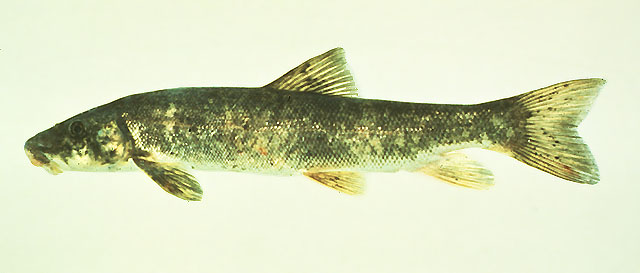| Catostomidae (Suckers), subfamily: Catostominae |
| 64 cm TL (male/unsexed); max.weight: 3,300.0 g; max. reported age: 20 years |
|
demersal; freshwater; brackish; pH range: 6.5 - 7.80000019073486; dH range: 5 - 25; depth range - 180 m |
| North America: throughout most of Canada and Alaska; Atlantic Slope south to Delaware River drainage in New York, USA; Great Lakes basin; upper Monongahela River drainage in Maryland and West Virginia, USA; Missouri River drainage south to Nebraska and Colorado, USA. Also in Arctic basin of Siberia in Russia. Occurs in Columbia River System (Molly Hallock, pers. comm.). |
|
Dorsal spines (total): 0-0; Dorsal soft rays (total): 9-11; Anal spines: 0-0; Anal soft rays: 7-7; Vertebrae: 45-47. Distinguished by the sucking mouth located on the ventral sides of the head and thick papillose lips (Ref. 27547). Gill rakers short; lateral line complete, inconspicuous; caudal tips slightly rounded (Ref. 27547). Adults may be reddish brown, dark brassy green or black above, paler on the lower sides, with the ventral parts white; young fish are usually dark gray with small black spots; breeding males are usually dark above with a brilliant reddish stripe along each side, while females are greenish gold to copper, with a less brilliant red stripe; breeding males show prominent tubercles on the rays of the anal and caudal fins and also on the head (Ref. 27547). |
| Found in clear, cold, deep water of lakes and tributary streams; occasionally found in brackish water in the Arctic (Ref. 5723). Moves from lakes into inlet streams or from slow, deep pools into shallow, gravel-bottomed portions of streams to spawn (Ref. 27547). Feeds on benthic invertebrates (Ref. 1998). Young are preyed upon by other fishes and fish-eating birds; while adults in spawning streams are taken by mammals, osprey and eagles (Ref. 1998). Utilized as a food fish or as dog food (Ref. 27547). |
|
Least Concern (LC); Date assessed: 21 February 2020 Ref. (130435)
|
| harmless |
|
Found in eastern Siberia, from the Yana to the Anadyr rivers (Ref. 27547). Transferred to northwestern Russia for aquaculture (Ref. 26334). This has been translocated to several areas for aquaculture (captive culture), escaped to the wild but failed to establish self-sustaining populations (Ref. 45022). Introduced in 1978 from Siberia to Kopore, Neva and Kovashi drainages. No evidence that this has established breeding populations (Ref. 59043). nEurRus |
Source and more info: www.fishbase.org. For personal, classroom, and other internal use only. Not for publication.

